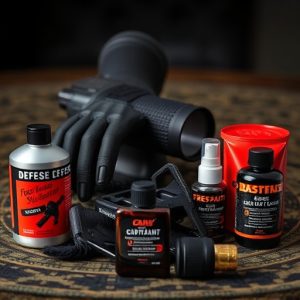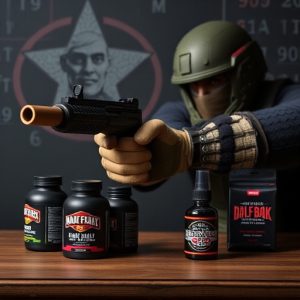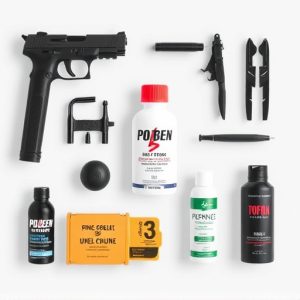Pepper Spray in Personal Defense: Science, Selection, and Legal Use
Pepper spray is an effective non-lethal self-defense tool that temporarily incapacitates attackers …….
Pepper spray is an effective non-lethal self-defense tool that temporarily incapacitates attackers by causing intense irritation to their eyes, skin, or respiratory tract. It contains capsaicin, which triggers a strong reaction upon contact, allowing users to maintain a safe distance and avoid physical confrontation. The spray comes in various forms, including keychain and pocket-sized canisters with added features like UV marking dye for identifying assailants later. Users must be trained in its correct application and understand the legal implications of using it. Pepper spray's effectiveness is based on its ability to disable an attacker, providing an opportunity to escape or for authorities to intervene. It's a safer alternative to firearms and is increasingly used by both civilians and law enforcement. When selecting pepper spray, consider the delivery system, concentration, and volume to suit your personal defense needs. Always adhere to legal regulations that vary by jurisdiction, and practice with the product to ensure proficiency in its use. Regular maintenance and awareness of wind direction are important to prevent misuse or harm. Pepper spray is a crucial component of a comprehensive personal defense strategy when used responsibly and legally within the guidelines provided by manufacturers and local laws.
When it comes to personal defense products, pepper spray consistently stands out as a non-lethal deterrent. This article delves into the essentials of pepper spray, exploring its scientific makeup and effectiveness in self-defense scenarios. We’ll guide you through selecting the ideal pepper spray for your specific needs, ensuring you’re well-informed on the product’s legal use and best practices. Whether you’re a seasoned user or new to personal defense products, this comprehensive overview will empower you with knowledge crucial for making informed decisions about your safety.
Understanding Pepper Spray: A Key Component of Personal Defense Products
Understanding pepper spray as a crucial element within personal defense products is essential for those seeking to enhance their safety and security in potentially threatening situations. Pepper spray, also known as OC (oleoresin capsicum) spray, is a non-lethal self-defense tool that temporarily incapacitates an assailant by causing intense irritation to the eyes, skin, and respiratory system. When faced with aggression or violence, the rapid onset of effects can provide valuable time for the user to escape to safety. It’s composed of a blend of natural capsaicin derived from chili peppers, which is formulated to deliver a potent and disabling reaction upon contact. The effectiveness of pepper spray lies in its ability to be deployed from a safe distance, minimizing the risk of physical confrontation and offering a viable alternative for personal defense. Users can choose from various types of pepper sprays, including keychain models, pocket-sized cans, and sprays with UV marking dye to aid in identifying an attacker post-incident. These products are designed to be user-friendly and legally permissible in many jurisdictions for personal protection. It’s important for individuals to familiarize themselves with the proper use and legal implications of pepper spray as part of their comprehensive approach to personal defense. Regular practice and understanding the limitations and capabilities of this tool can empower users to respond effectively to a variety of physical threats.
The Science Behind Pepper Spray and Its Effectiveness for Self-Defense
Capiscin, the active ingredient in pepper spray, is a highly effective irritant that temporarily incapacitates an assailant. It triggers a strong reaction in the eyes, nose, throat, and skin of those who come into contact with it, leading to an intense burning sensation and significant pain. This response is due to the compound’s interaction with sensory receptors, particularly TRPA1 and TRPV1, which are part of the body’s pain detection system. When deployed, the irritant quickly penetrates the mucous membranes and skin, causing uncontrollable coughing, tearing, blurred vision, and an inability to perform tasks requiring fine motor skills. These effects can last from 20 to 45 minutes, providing a critical window for escape or for law enforcement to apprehend an attacker. The effectiveness of pepper spray as a personal defense product is underscored by its use by police forces worldwide and its growing popularity among civilians for self-defense due to its non-lethal nature and ease of use. It is a reliable tool for personal safety, designed to defend against threats with minimal risk of injury or long-term harm to both the user and the aggressor.
Choosing the Right Pepper Spray for Your Personal Defense Needs
When considering pepper spray as a personal defense product, it’s crucial to assess your specific needs and circumstances. The efficacy of pepper spray lies in its ability to incapacitate an attacker by causing intense irritation to their eyes and respiratory system. This non-lethal self-defense tool is widely regarded for its accessibility, legal status in many jurisdictions, and ease of use. When selecting the right pepper spray, factors such as delivery mechanism, pepper spray concentration, and the quantity of product are essential considerations. For instance, a keychain model offers portability and quick access, while a larger canister with a higher Scoville Heat Unit (SHU) measurement may provide a stronger burst for more effective defense.
Additionally, it’s important to evaluate the type of pepper spray that suits your personal defense strategy best. Options range from traditional sprays to foam-based and gel variants, each with its advantages. A foam or gel might be preferable in indoor environments where overspray is a concern, while a conventional spray can cover greater distances for outdoor scenarios. Furthermore, certain pepper spray products come with added features such as UV marking dye to aid law enforcement in identifying your assailant, or models with safety and training mechanisms to prevent accidental discharge. Tailoring your choice of pepper spray to your individual defense needs ensures that you are well-prepared should the need arise, making it a prudent addition to your personal defense products arsenal.
Legal Considerations and Best Practices When Using Pepper Spray for Protection
When considering personal defense products, pepper spray emerges as a non-lethal option widely used for self-defense. Its legal status varies by jurisdiction, with some regions strictly regulating its purchase, possession, and use. It’s imperative to familiarize oneself with local laws to avoid inadvertent violations that could lead to legal repercussions. Understanding the scope of these regulations is crucial for responsible ownership and deployment. In addition to adhering to legal considerations, best practices for using pepper spray include situational awareness and understanding its range and effects. The chemical compound within the spray, typically oleoresin capsicin, causes irritation upon contact with mucous membranes, leading to temporary incapacitation of an assailant. Users should practice with their chosen pepper spray to ensure proficiency in deployment under stress. Moreover, maintaining the device in accordance with the manufacturer’s instructions ensures its effectiveness when needed for personal defense. Safety precautions also dictate that pepper spray should be directed away from oneself and bystanders due to its potent effects. By integrating legal knowledge with best practices, individuals can employ pepper spray as a component of their personal defense strategy effectively and safely.


